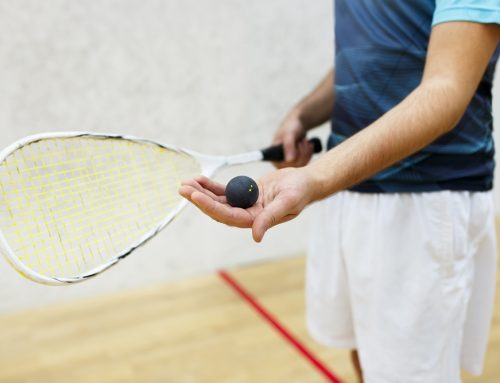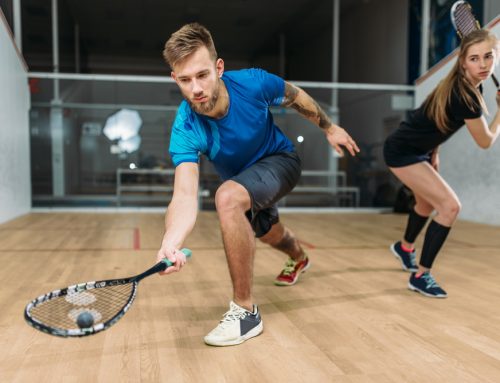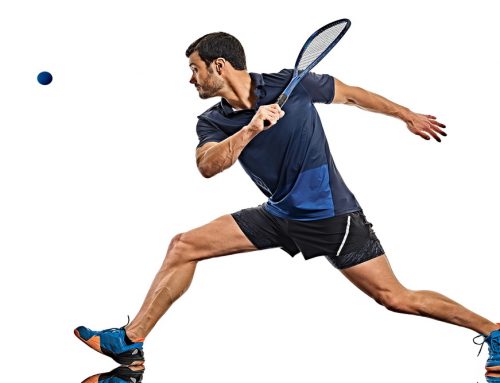‘Now you know how to grip it, the next question to ask yourself is how do I rip it?’
Over the next two articles we will look in depth at the two swings; forehand and backhand. When referring to the swing throughout these articles we are considering the basic drive shot down the wall. If you have ever attended squads or had private lessons before you will be well adverse to doing hundreds of straight drives in your sessions, this is partly due to the fact hitting good length and width is one of the keyfoundations to anyone’s game, but also coaches regularly use this exercise to analyse players basic technique with few other variables involved. This allows the coach to diagnose the problems and symptoms, then present remedies.
The swing has to alter slightly when playing specific shots such as the drop shot; the lob; the volley etc and at times the swing has to adjust to various situations but more about that in later articles when studying the shots themselves in greater detail. We will be looking at the forehand and backhand swing independently as they are quite different from one another. Let us start with the forehand.
Have you ever wondered how a small skinny eleven year old can hit a ball twice as hard as a muscle bulging thirty year old? To get the most out of your forehand stroke it is important to develop, timing, efficiency, consistency and the correct pathway of your swing, In one word ’technique’. Your physical actions dictate the swings pathway. Using the ‘whole part whole’ method of learning, first we need to consider the action as a whole, next break it down into bite size pieces, before finally rebuilding it whole once again.
Similar to the grip previously discussed in article 2, if your basic swing progresses as it should your forehand will have no limitations, you will be able to hit with both great power and delicate touch transferring effortlessly between the two, you will have many choices of shots, you will be able to hit early or late, attack and defend and adjust your swing size when required e.g. the back corners.
The best analogy I have found over the years is to think of the forehand swing resembling trying to skim a stone across water. Remember those days before isolation and lockdown when you could visit your favourite beach? At this point feel free to stand up and mime standing at the water’s edge skimming a stone out to sea.
The first thing you should be doing after picking up the stone is turning side on to get your feet in the same position as a golfer would do teeing off, in squash terms we refer to this as rotating. Whilst rotating we can begin to draw back the throwing arm (the backswing) bending the elbow taking the stone back towards the top of the swing. Within this same action lift your non throwing arm away from your body in unison and point towards your target. When teaching young juniors I call this the Robin Hood position as it resembles an archer. You can still achieve more rotation by puffing out your chest and twisting at the waist, you may find when doing this extra bit of rotation your weight transfers onto your back foot causing your heel to raise slightly on your front foot, this is all great news as this extra bit of rotation is where so much of the hidden power comes from, finally make sure at this point you cock or flex the wrist, like pulling back the throttle on a motor bike. Cocking the wrist is of major importance because as you progress through the years possibly to an advanced level you can start to reduce your basic swing and use the wrist instead, but this takes years of practice as all the other components have to be perfected first. The position you are now momentarily held in should resemble a coiled spring ready to strike.
This sounds like a lot when you break it down in to bite size components and this is just the back swing, but remember ‘whole part whole’. This whole backswing preparation is done in one action, ever heard the expression ‘killing two birds with one stone?’ Through practice all of these components within the backswing must happen in unison, sub consciously and correctly.
‘Several bite size components’
Rotating to side on, draw back racket arm, bend the elbow, point at target with non racket arm, puff out the chest and further rotate at the waist, transfer your weight onto the back foot, raise the heel of your front foot, flex your wrist
=
‘One action’
Back swing / preparation
The first time you mimed this preparation to skim a stone you probably did it slowly and methodically, component by component double checking you are doing it correctly. Now speed it up, make the parts whole again in one fluid economic motion, but take care not to miss out any of the individual components, otherwise it will also be missing from the whole. Find a space outside and try this backswing motion holding your actual squash racket, you could do it inside but I don’t want to get the blame for a smashed lampshade!
The longer you are in the ready to throw or hit position (top of swing) the better. The backswing and downswing are separate entities there should be an obvious pause at the top of the swing. One of the biggest differences I see between novice and advanced players is the length of time they are held in this ready state, momentarily paused ready to strike. Beginners and low level players often have no pause at all. Have you ever thought ‘how come good players look as though they have so much time?’ The longer you are in this position for the more time you have, to stabilise yourself, weigh up your options, hold your shot, hold your opponent still stopping their momentum, delaying them and forcing them to guess early and hopefully guess wrongly, use the time to think about where they are or where they are heading to, change your initial shot if required, focus on the ball, react to unexpected bounces or lack thereof, and select the right option.
So when should you start your backswing? As soon as you know where your opponents shot is going. I often get my one to one pupils practicing this in the knock up, this is the best time to do it as don’t forget through repeated practice you will create habit, and this is a great habit. Try this next time you are back on court. In the knock up look across at your opponent as they play their warm up shot, through looking at them as they execute their shot you can quickly determine whether they are hitting the ball straight back to themselves for an extra warm up shot or cross courting over to you. If it appears to be coming across start the backswing process ASAP, I still flinch in a knock up even when my opponent hits straight back to themselves, this is my sub conscious reacting, starting my backswing preparation for my shot before my eyes and brain recognise it isn’t in fact a cross court and I can relax again. When doing this practice, your backswing should be completed before the ball reaches you and definitely before the bounce, if it is not ready before the bounce how are you ever going to take the shot early or volley??
Next we are going to look at swinging the racket towards the ball ‘the downswing’. This part of the swing is hugely important when considering power. Players get a lot of their power from ‘the snap’. The speed the downswing generates will determine the amount of snap you create upon impact.
Every component within the downswing should work towards transferring the weight forwards. There are a few things that happen simultaneously, the waist starts to untwist, the elbow leads the downswing, the non playing arm moves back towards the body and the front foot brings its heel back to the floor. For me the elbow is the most important factor here as poor unorthodox swings often fail at this. The elbow should be heading down towards your hip with the rackets handle and racket head still lagging behind. At this point I sometimes use a couple of analogies to identify with this, the elbow movement towards the hip should make the racket head draw a backward letter ‘C’, or another way to think about it is to imagine spinning a bicycle wheel with your hand, stand up and try this in slow motion. This action as a whole should now be really starting to resemble skimming that stone.
As your downswing gets ever closer impact your arm should be gradually starting to straighten, un-cocking the wrist, this allows the handle of the racket to catch up. Finally the racket head comes flinging through last. At the moment of impact the elbow should be fully locked out with everything else; the arm, elbow, wrist, racket handle and racket head all in a perfect line, this is the snap! By now your front foot should be firmly flat on the floor and your back foot heel has probably come up like a golfer teeing off as your weight throughout the downswing has transferred from back foot to front foot. If at this point your distance from the ball is wrong and you are to close, you will not be able to snap, your swing will have to compensate reducing both the power and accuracy of your shot, so do not get to close!
Several bite size components
Weight transferring to front foot, untwist the torso, take the elbow to the hip, begin straightening the arm, bring the handle through, un-cocking the wrist, whip the racket head through last, lock out in perfect line, weight on front foot
=
One action ‘The downswing to impact’
Now let’s talk about the follow through, this is where all your hard work could be undone. The follow through is sometimes just an afterthought for many players as they’ve struck the ball and quickly move on. However, the follow through is very important as it helps with your accuracy and control, guiding the ball through to its chosen target, as well as assisting your momentum back towards the centre of the court. The destination of the follow through is either high or low rarely in between. Hitting down on the ball for a short shot will have a naturally low follow through or hitting under the ball for pretty much everything else should have a naturally high follow through. Never around the body, save that for baseball! If your forehand follow through is ending up in the middle area you are probably guilty of turning the hand over through impact and topping the ball, if you do this severely you will basically end up playing a top spin tennis shot, this is rarely needed in squash as you can not generate much power with top spin, you can not get under the ball and all your shots will end up heading down towards the tin. To avoid this try to keep the rackets bottom edge cutting through the downswing, the impact and the follow through for as long as possible until the swings natural end. Try some solo practice using a soft chip shot to focus on developing this correctly.
‘Several bite size components’
Lead with racket heads bottom edge for as long as possible, guide the ball towards its destination, high or down pathway depending on shot selection, never around the body or rolling the hand over and topping, decelerate naturally
=
One action ‘The follow through’
The final tip I would like to give you regarding the swing is ‘use your head’. Any sport involving striking a ball requires your eyes to be locked on to the ball and your head still throughout the stroke. Your head should remain still for an almost exaggerated amount of time, this has logical, measurable benefits not just aesthetics. Keep it still all through the downswing, the impact and even the follow though. Lifting the head to early will also remove your eyes from the ball early causing miss hits, over rotation, tilting and loss of balance, as well as telegraphing where you are hitting the ball to your opponent. Keeping the head still for a slightly more exaggerated time than you would think normal will cure most of these issues, try it next time you are on court. One reinforcement command I often call out to my pupil when practicing keeping the head still is to stay looking at where the ball was for a split second after impact before looking up.
If anyone has ever watched me play before or in fact any of my advanced juniors who have been with me a while you will observe this happening. You can sometimes exaggerate the head position even further if trying to remain balanced at full stretch or when trying to apply disguise and deception on your shots.
Look out for my next article coming soon ‘the backhand’. Find out why for many players this often starts out as the weaker side but over time with practice can end up more reliable, accurate and consistent than the forehand!
Stay safe
Pallen




